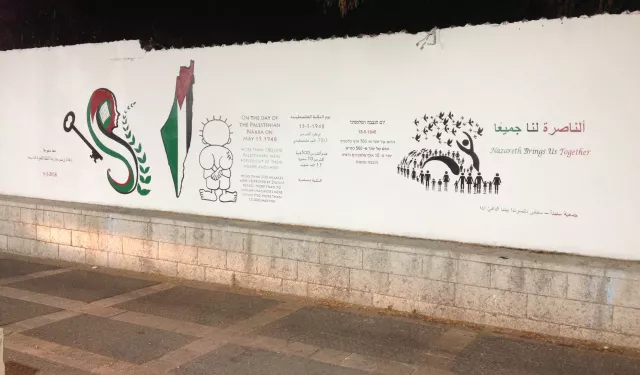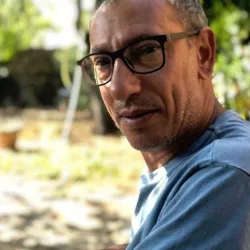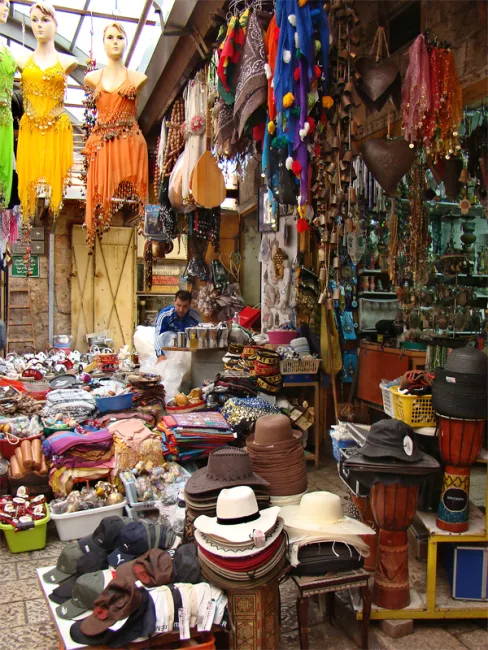
Walls between us| Possibilities for and with Palestinians
In the first article of this series, I used the subheading “The solitude of the defeated.” This phrase referred to all of us—Palestinians and advocates for Palestinian rights—experiencing how defeat can lead to isolation.
Yet, the term resonates beyond the immediate anguish, evoking a different kind of solitude: that of Palestinians living within Israel's 1948 borders. They are routinely obscured by Zionist propaganda as mere "Arab Israelis," a label designed to strip them of history and connection, when the more precise and potent truth remains: they are the Palestinians of the occupied territories, an isolated reality rarely given its due voice.
Nearly 2 million people fall into this category, carrying Israeli identification papers. For too long, they've faced stringent, arbitrary, and frequently unwritten rules of boycott —especially cultural boycotts—against Israel, simply by virtue of the documents they're compelled to carry. Their so-called "misfortune" was merely remaining on their ancestral land while their relatives and neighbors endured forced displacement during the first Nakba.
We frequently ignore the fact that some Arab countries, Egypt foremost, often deny them entry or expel them, depending on the occasion or political moment, while granting Israeli tourists and businessmen entry, protection, and freedom of movement.
This disregard for the plight of the 1948 Palestinians is often justified under the banner of “collateral damage.” To uphold and solidify the boycott, we must, it seems, ignore its impact on this particular group of Palestinians.
The curse of official documents
The issue goes beyond the difficulty of traveling to or interacting with the Arab world. The real tragedy is that the ad hoc, reactive nature of the boycott movement—launched in the 1970s in response to Sadat’s initiatives and subsequent agreements—abandoned the 1948 Palestinians to confront Israelization on their own. This campaign wasn’t just about political isolation. It sought to erase their language, culture, and identity, and to sever their natural ties with the broader Palestinian people and their historical struggle.
The boycott rules never accounted for the need to protect this sector of the Palestinian people from harm. Ironically, the Arab countries they can visit and occasionally connect with are precisely those that have normalized ties with Israel—Egypt, Jordan, the UAE, and others. Meanwhile, they are cut off from the rest of the Arab world, especially the so-called “resistance states,” because it is impossible to enter those countries with an Israeli passport, and visiting them is also a crime under Israeli law.
No serious attempt has been made to circumvent this double ban, except through rare exceptions or during pilgrimages.
In the previous article, I quoted a friend—film critic and researcher Samah Bsoul—who knows very well how often Arab anti-Zionist professionals in her field avoid her and others like her, despite her being Palestinian, simply because she holds an Israeli passport.
Samah Bsoul says, “There’s a form of classification that carries a kind of stigma. This state of severance and isolation has gone beyond ignorance and fear; in many cases, it has become deliberate. In an era of digital openness, you can’t keep treating Palestinians from the 1948 territories like ticking time bombs. It doesn’t take more than reading a few pages of history to see that these are people who stayed on their land despite the occupation. Can you really judge someone by what’s written on a piece of paper and not by their conscience, belonging, or innate identity?”
The bitter irony known to Samah, is that the isolation of the defeated, those besieged inside Israel and forced to deal with their enemy at every turn, has been deepened by decisions made by other Palestinians.
Beginning with the PLO’s acceptance of the delusory two-state solution, a slow abandonment of this group took hold. They became a sacrificial offering to Israel, expected to settle for life as second-class citizens in the occupying state. They were then asked, for the sake of regional peace and for Israeli citizens to “enjoy” stability, to put up with this discrimination and integrate into a Zionist system that rejects their existence and seeks to erase them.
Shifting standards of boycott
In late 1970s, especially after Sadat’s visit to Jerusalem, Arab intellectuals and leftists, particularly in Egypt, operated under two opposing emotional states. The first was sheer shock and dread. A relevant symbol here is Amal Dunqul’s poem “Do Not Reconcile,” especially when heard in his voice—a poet’s cry warning of a coming catastrophe, steeped in tragic imagery from the pre-Islamic war of Al-Basus.
The second state was evident in writings and cultural practices of the time: a steadfast confidence that Egypt would resist normalization. Even if the state signed treaties, the people would remain an impenetrable wall, protecting the nation from Zionist infiltration.
In this atmosphere, oscillating between shock and certainty, Cairo saw the formation of the Committee for the Defense of National Culture. It brought together some of Egypt’s most influential intellectuals, artists, and politicians to embody that protective wall, especially against cultural normalization. But because confidence was often overwhelming, albeit tinged with sorrow, the committee failed to establish clear foundations for what boycott meant or how normalization should be resisted. Over time, the committee’s presence and influence waned, eventually disappearing altogether.
There was an objective factor justifying this oversight: the terms for rejecting normalization back then were clear and simple: no collaboration with Israelis, particularly not in shared spaces. But this simplicity opened the door to two phenomena: first, an overly personalized approach to boycott guidelines by relying on the moral standing of prominent individuals; and second, case-by-case handling.
For instance, playwright Ali Salem was harshly criticized for visiting Israel, while other intellectuals who did the same were met with silence. Reactions depended on subjective criteria: what the person said upon return, their reasons for going, or how they justified the normalization act.
This individualism, relying on reputable figures in cultural and political spheres, stood in the way of creating objective, evolving guidelines. Criteria that would allow every intellectual to make an informed choice, stand by it, and either defend it or pay its price. This became more urgent in the absence of such public figures and the cultural-political drought that followed in Egypt.
The 1970s came to an end; the era of Sadat’s own individualism outside the Arab consensus. The states of fear and confidence faded too. Four and a half decades later a new and far more tangible threat has emerged, one we all recognize even if some choose to ignore it to protect their interests.
Normalization, joint ventures, Israeli regional dominance, Arab capitulation to occupation, and the refusal to take a political stand against genocide are no longer limited to Egypt. The danger has spread taking new forms far beyond symbolic Israeli participation in Cairo book fairs or trade expos.
The Gulf-Israeli axis today is a colossal force, far beyond Sadat’s power in the past. With limitless financial resources, it attracts thousands of intellectuals and artists whose ideas shape millions of Arab workers in the Gulf. These workers, in turn, gravitate towards better opportunities there rather than remain in their struggling home countries. These immense resources now threaten to subjugate formerly pioneering Arab nations, reducing them to satellite states orbiting Gulf palaces.
This is what demands urgent, unflinching confrontation. But such confrontation cannot rely on the personal standards of individuals we admire or small cliques of like-minded intellectuals. To be effective, these standards must emerge from real, serious dialogue among all forces committed to opposing the Zionist project. Whether such dialogue is even possible remains uncertain.
The resistance to come
Palestine’s growing presence in both collective and individual global consciousness, as a moral and existential touchstone, is a hallmark of this new era. This is evident in how Palestinian symbols appear at hundreds of local and national protests around the world.
Another feature of this moment, shaped by the enormity of the ongoing genocide, is that no one can predict what’s next. Especially whether resistance will evolve politically and socially worldwide, or militarily within Palestine and the broader Arab world.
We cannot foresee even fragments of the future because the consequences of this genocide are still unfolding. Yet, despite this unpredictability, certain signs point to what may lie ahead. One is the renewed importance of organized political struggle within Palestine. A notable example was the general strike in the West Bank, staged by resistance factions in response to recent repression by the Palestinian Authority in several camps and towns.
Perhaps—perhaps—the era of large, organized resistance formations like Hamas or Hezbollah may be ending. The future may belong to small, dispersed groups that strike where least expected, then disappear, or are suppressed, only to be replaced by others.
In such a landscape, while boycotting the enemy remains essential, we must also rethink how we engage with Palestinians from the 1948 territories. We must reassess our position towards those emerging from within Israeli society to become its enemies. How do we support them? How do we welcome them into the global ranks of those rejecting Israel’s existence?
Edward Said once said we must win the minds of our oppressors, but we must also win their conscience—help them find peace in supporting our aspirations.
As the effectiveness of that old historical scarecrow—accusations of antisemitism—diminishes, losing its coercive power, it’s crucial for every dissenter against Zionism and the Israeli state to know this: There is no other land for Palestinians but historic Palestine.
And they must also know that there is a place for them in our dream of a unified, secular, democratic Palestine from the river to the sea for all its citizens and for every Palestinian forcibly displaced from it. A homeland without supremacy of religion or race. A land without walls between us.
Published opinions reflect the views of its authors, not necessarily those of Al Manassa.

